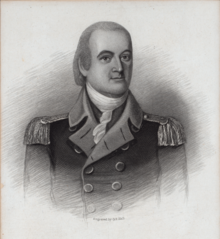
Back ويليام ألكسندر لورد ستيرلينغ Arabic ويليام الكسندر لورد ستيرلينج ARZ William Alexander, Lord Stirling German ویلیام الکساندر، لرد استرلینگ Persian William Alexander (generale) Italian ウィリアム・アレクサンダー (アメリカ独立戦争) Japanese William Alexander (lord Stirling) Polish Александер, Уильям (лорд Стирлинг) Russian 斯特靈勳爵威廉·亞歷山大 Chinese
William Alexander | |
|---|---|
 | |
| Born | December 27, 1725 New York City, New York, British America |
| Died | January 15, 1783 (aged 57–58) Albany, New York, U.S. |
| Allegiance | |
| Service | |
| Years of service | 1775–1783 |
| Rank | Major General |
| Commands | 1st New Jersey Regiment Continental Army (2 months) |
| Battles / wars | |
| Spouse(s) |
Sarah Livingston
(m. 1747) |
| Relations | Philip Livingston (father-in-law) William Livingston (brother-in-law) |
William Alexander, also known as Lord Stirling (December 27, 1725[1] – January 15, 1783), was a Scottish-American major general during the American Revolutionary War. He was considered male heir to the Scottish title of Earl of Stirling through Scottish lineage (being the senior male descendant of the paternal grandfather of the 1st Earl of Stirling, who had died in 1640), and he sought the title sometime after 1756. His claim was initially granted by a Scottish court in 1759; however, the House of Lords ultimately overruled Scottish law and denied the title in 1762. He continued to hold himself out as "Lord Stirling" regardless.[2]
Lord Stirling commanded a brigade at the Battle of Long Island, his rearguard action resulting in his capture but enabling General George Washington's troops to escape. Stirling later was returned by prisoner exchange and received a promotion; continuing to serve with distinction throughout the war. He also was trusted by Washington and, in 1778, exposed the Conway Cabal.
- ^ "Individual biography". www.albany.edu. Retrieved April 12, 2024.
- ^ Abbe-Barrymore (1928). "Dictionary of American Biography". Charles Scribner's Sons, New York. pp. 175–76. Retrieved April 6, 2015.